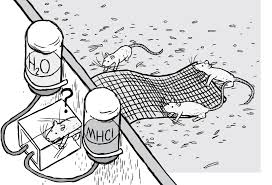Dr. Keith Lopez, PhD Natural Health and Nutrition, University of Natural Health and Gaurav Dubey (MS Biotechnology) authored this article.
According to the CDC, 70,237 deaths are attributed to opiates each year.1 How can so many deaths be attributed to a substance that is prescribed for pain from the dentist or the doctor? Why do some people get addicted to opiates, while others can take hydrocodone for their pain, and then discontinue use after the prescription is finished? It would be a lesson in the power of the written word if a blog article could break the chains of opiate addiction, so we’ll settle for providing some information and tools to help anyone who might be struggling.
Landmark “Rat Park” Study Questions Traditional Addiction Narrative
Johann Hari, in his TED talk, spoke about addiction with the above questions in mind. He looked at a landmark addiction study, where “caged, isolated rats addicted to cocaine, morphine, heroin, and other drugs will self-administer in very high doses, foregoing food and water, sometimes to the point of death.”2 Created by Professor Bruce Alexander, the well-known study has been dubbed the “rat park” study, wherein caged and isolated rats were compared with rats that had more of their social wants and needs provided for. The “rat park” was a “spacious, comfortable, naturalistic setting, where rats of both sexes were able to cohabit, nest, and reproduce.”2 While both groups of rats were provided morphine-laced water, the caged and isolated rats exhibited very different behaviors than the rats in the “rat park.”

“Rat Park” Study Suggests Social Connection Is Fundamental to Recovery
When rats were provided with a healthy environment instead of an empty cage, they did not choose to use the drug more than once, even though cocaine or heroin was readily available. In fact, in the second phase of the experiment, rats were given consistent doses of morphine until they became physiologically dependent, and were then returned to either an isolated cage or the “rat park.” Much to the researchers surprise, the rats in the “rat park” chose to willingly endure opiate withdrawal so they could be sober again and form better social relationships with their fellow rats. This begs the question: how many humans live in empty cages? What exactly will fill a human’s “cage” and completely fulfill one’s needs and wants? Johann Hari mentions a 15-year experiment in Portugal where the main goal of the particular rehabilitation program was to provide purpose and connection to society by establishing skill sets within drug addicts. According to the British Journal of Criminology, injection use went down by 50%, and all addiction rates decreased.3

To obtain more connection and purpose in life, it will most likely take more than one step. Here we examine a few evidence-based strategies that may help create and facilitate this connection to personal fulfillment. Some of these steps are directly linked to rehabilitation, while others are simple techniques geared toward optimizing overall health and well-being.
- Eat Your Medicine: Many foods can help facilitate improved mood and feelings of well-being. Furthermore, avoiding foods that aggravate your body is also an important first step in cultivating sustainable health and happiness. An allergy is an obvious example that may make someone feel lethargic, itchy, and foggy-headed. These feelings are certainly associated with addiction, along with nausea. Not feeling good is often dealt with by taking a pill, although a slice of raw ginger may be even more effective at combating nausea. As Hippocrates stated, “Let food be thy medicine and medicine be thy food.”

Additionally, fruits and vegetables contain chemicals called phytonutrients. These are naturally occurring pesticides within produce, also called antioxidants. There are over 10,000 phytonutrients known,4 and many have not yet been studied. Recently, sulforaphane, which is found in cruciferous vegetables like broccoli and kale, and which is 100 times more abundant in broccoli sprouts, has been studied in cases of cancer, schizophrenia, and stomach ulcers. It was noted to kill “bad” bacteria, and it is documented to protect against some cancers, along with supplying protection against neurodegeneration and CVD risk.5
Eating with the colors of the rainbow in mind can also help to obtain the benefits of phytonutrients. Eating fresh produce provides many essential nutrients, such as fiber, which also creates “good” bacteria, working as a probiotic. Creating a gut biome of good bacteria has been known to greatly affect mood, and has been written about by many, including Harvard, with the catchy title: Gut feelings: How food affects your mood.6
The elimination diet can greatly help in finding foods that cause a reaction similar to an allergen. A few base foods are the beginning of the diet, such as bananas, cherries, grapes, and rice. You then add foods one by one, taking note of how you feel, and then repeat the addition of that food three times. Although this method is highly effective, it is not always practical. Another option is to remove a certain food from the diet and take note of the effect.
Managing Digestive Disorders While in Recovery: Personal Insight from Co-Author Gaurav Dubey
I am all too familiar with the distress and anxiety that comes with managing severe GI issues. However, staying on top of my diet and caring for my gut has been an extremely crucial part of my recovery. In fact, when my digestive issues flare up, the sensations I experience are eerily similar to opiate withdrawal (cold sweats, cramps, anxiety, nausea, and other unpleasant symptoms). When I experience these symptoms, I sometimes start to panic and feel the urge to take “something” to feel better. Unfortunately, in my experience, there is no medication or drug that really provides relief. I just have to wait it out and make sure to be very careful with my diet moving forward. Maintaining sanity and peace of mind is crucial for me to stay sober and, as such, staying on top of my diet and treating my body with love and care is imperative to living a happy, healthy, and sober life.

- Cognitive Behavioral Therapy (CBT): This can be done simply with a journal. First write about a situation that you notice provokes an extreme emotional response. Be very specific, and assign a number, 1-100, to create a metric for how you feel. Now visualize responding to the situation in a different way, and then evaluate your metric of the same emotion with a 1-100 number.
This practice is best done consistently, with the inclusion of each step. Visualization is a practice just like physical exercise, and builds new neurological pathways. The more you practice visualizing, the easier it gets, and the more details will become apparent. The practice of journaling also enables recognition of automatic thoughts. Negative thoughts that limit behavior and increase anxiety or depression can be recognized, written down, and rationalized to be false and limiting. Click here to learn more about how CBT and other therapies can help treat chronic pain without the use of addictive drugs. To learn more about how our team at Evolve Indy can help you, or a loved one, with drug addiction, set up a free consultation with our clinical team today!

- Exercise: Exercise is the number one prescription for depression. This is unfortunately not used to its full advantage, as about 40% of U.S. adults were sedentary in 1997, engaging in no leisure time physical activities of any kind.3 The shift from no exercise to regularly exercising can make the difference between depression and expression of happiness.
- Know your Ikigai, or your “reason for being”: Ikigai is a Japanese term that roughly translates to one’s “reason for being.” It is the nurturance of life’s fruit and the devotion that helps it blossom. However, many people establish a sense of identity through their occupation, and can therefore lose their identity and purpose when they retire. “Oregon State University researchers found that healthy adults who retired one year past age 65 had an 11 percent lower risk of death from all causes, even when taking into account demographic, lifestyle, and health issues.” As Johann Hari points out in his TED talk, a person who does not feel they have a reason for being is likely to abuse drugs and become an addict. Discovering one’s purpose for being may indeed be one of the most important steps in cultivating a successful recovery, never mind retirement.
Closing Thoughts on the Importance of Maintaining Good Health in Recovery Treatment
In a society where 647,457 people died from heart disease in 2017, and more than twice as many people die from suicide (47,173) than homicide (19,510), it is refreshing to know that we can at least have control over our health.8 Understanding that happiness and a mentality of well-being can be a natural, endogenous state is an empowering concept—especially for those in recovery. After years of drug and alcohol abuse, it takes time and patience for genuine healing. But it is attainable, and the “normal” pleasures of life (like good food, sex, and nature) can eventually come to elicit a similarly enthralling response that was once captured through drugs. Careful and deliberate self-care can greatly help facilitate this process and help addicts in recovery get back to feeling some sense of “normalcy” much faster. On a broader scale, these ideas can also shift the negative lifestyle habits of society at large to a more pristine state, helping to discourage addictive behavior to begin with. I think most people can agree that we would much prefer the love, happiness, and creative activity that springs from healthy communities and relationships. These steps can help everyone (not just addicts in recovery) transcend resentment and depression, while also helping to cultivate new meaning and purpose in our lives. If you or a loved one is struggling with addiction, reach out to our clinical team at Evolve Indy to setup a free consultation today.

Works Cited
- Drug and Opioid-Involved Overdose Deaths — United States, 2013–2017 | MMWR. https://www.cdc.gov/mmwr/volumes/67/wr/mm675152e1.htm.
- Pickard, H. The Purpose in Chronic Addiction. AJOB Neurosci. 3, 40 (2012).
- Campbell, B. Drug decriminalisation in Portugal: setting the record straight. Transform Drug Policy Foundation https://transformdrugs.org/drug-decriminalisation-in-portugal-setting-the-record-straight/ (2018).
- Heneman, K. & Zidenberg-Cherr, S. Nutrition and Health Info Sheet: Phytochemicals. (University of California, Agriculture and Natural Resources, 2008). doi:10.3733/ucanr.8313.
- Libro, R., Giacoppo, S., Soundara Rajan, T., Bramanti, P. & Mazzon, E. Natural Phytochemicals in the Treatment and Prevention of Dementia: An Overview. Mol. Basel Switz. 21, 518 (2016).
- Current Understanding of Gut Microbiota in Mood Disorders: An Update of Human Studies. https://www.ncbi.nlm.nih.gov/pmc/articles/PMC6389720/.
- Nanayakkara, W. S., Skidmore, P. M., O’Brien, L., Wilkinson, T. J. & Gearry, R. B. Efficacy of the low FODMAP diet for treating irritable bowel syndrome: the evidence to date. Clin. Exp. Gastroenterol. 9, 131–142 (2016).
- NIMH » Suicide. https://www.nimh.nih.gov/health/statistics/suicide.shtml.

